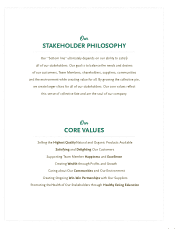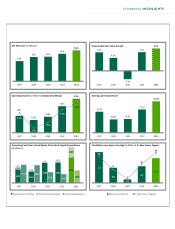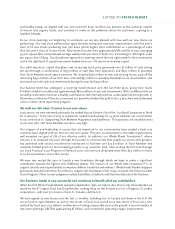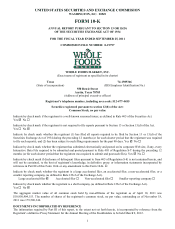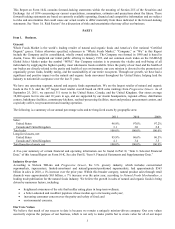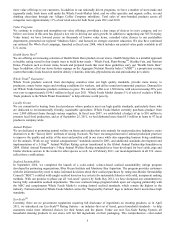Whole Foods 2011 Annual Report Download - page 12
Download and view the complete annual report
Please find page 12 of the 2011 Whole Foods annual report below. You can navigate through the pages in the report by either clicking on the pages listed below, or by using the keyword search tool below to find specific information within the annual report.
6
rating system will allow shoppers to easily identify a product’ s environmental impact and safety based on a red-orange-
yellow-green color scale. We are committed to working with our vendors to evaluate and independently audit every product
in our cleaning category, and all products in our stores will be required to meet our baseline orange standard by Earth Day,
April 2012.
Seasonality
The Company’ s average weekly sales and gross profit are typically highest in the second and third fiscal quarters and lowest
in the fourth fiscal quarter. Average weekly sales and gross profit are typically lower in the first fiscal quarter due to the
product mix of holiday sales, and in the fourth fiscal quarter due to the seasonally slower sales during the summer months.
Growth Strategy
We are a Fortune 500 company, ranking number 273 on the 2011 list. Our sales have grown rapidly due to historically strong
identical store sales growth, acquisitions and new store openings from approximately $92.5 million in fiscal year 1991,
excluding the effect of pooling-of-interests transactions completed since 1991, to approximately $10.11 billion in fiscal year
2011, a 20-year compounded annual growth rate of approximately 26%.
Over the last 10 fiscal years, our identical store sales growth has averaged approximately 7%. This growth was driven by an
average 4% increase in transaction count and an average 3% increase in basket size, a mix of approximately 60% transaction
count to 40% basket size. Our identical store sales growth for each of the last 10 fiscal years is shown in the following chart:
Approximately 18% of our existing square footage was acquired, and while we may continue to pursue acquisitions of
smaller chains that provide access to desirable geographic areas and experienced team members, such acquisitions are not
expected to significantly impact our future store growth or financial results. Our growth strategy is to expand primarily
through new store openings. We have a disciplined, opportunistic real estate strategy, opening stores in existing trade areas
as well as new areas, including international locations. We typically target stores located on premium real estate sites, and
while we may open stores as small as 15,000 square feet or as large as 75,000 square feet, the majority of our new stores are
expected to fall in the range of 35,000 to 45,000 square feet going forward.


